Abstract
Cucumis sativus L. plants are subjected to stress during production, affecting their growth, development, and fruit quality due to abiotic factors. Thus, the aim of this research is to evaluate Pseudomonas paralactis, Sinorhizobium meliloti, and Acinetobacter radioresistens plant growth promoting rhizobacteria (PGPR) effect on C. sativus plants under three substrate moisture levels (100, 75, and 50%). A randomized complete block design (RCBD) was used with an A x B arrangement: (1) factor A (inoculant) with four levels; (2) PGPR and control (without bacterium); (3) factor B (substrate moisture content) with three levels. Plant height, root length, and fresh weight increased by inoculating PGPR (121%, 135%, and 134%, respectively); likewise, these variables increased with higher moisture content (177%, 204%, and 234%, respectively), while the effect of the interactions of the PGPR and the moisture content in the substrate showed statistical differences in plant height increasing of 197% and root length of 267%. On the other hand, the content of phenols, flavonoids, and antioxidant capacity was statistically different (p ≤ 0.05) in inoculated plants, with PGPR increasing by 117%, 126%, and 150% respectively. In the moisture content of the substrate, statistical differences were observed, with an increase in the flavonoid content (114%) and antioxidant capacity (116%). The assimilation of nitrogen was higher by 274% and phosphorus by 124% with the PGPR inoculation, the moisture content increased the nitrogen content in the plant (257%) and the phosphorus content in plant (135%), showing significant differences (p ≤ 0.05). However, the interaction of PGPR and moisture content only presented statistical differences in nitrogen assimilation. PGPR can be considered as an alternative to obtain vigorous cucumber seedlings.
1. Introduction
Cucumber (Cucumis sativus L.) is one of the vegetables with the greatest global demand and consumption [1], and its fruit has a high nutritional value [2]. Seedling production has an important role, since fruit quality and cultivation depend on it and it influences abiotic factors on plant growth and development [3]. Soil moisture, temperature, and light are factors that have a bearing on biochemical, physiological, and morphological plant responses [4]. The lack of moisture in the soil may stress plants, increasing reactive oxygen species (ROS) that limit radicle growth [5]. To avoid ROS generation, phytochemical compounds, such as total phenol, carotenoid, ascorbic acid, and flavonoid, generate a non-enzymatic antioxidant capacity as a defense mechanism for the plant [6,7]. To mitigate stress by abiotic factors, plant-growth promoting rhizobacteria (PGPR) may be an option to increase plant tolerance to these abiotic factors [8,9]. Under low soil moisture conditions, PGPR have an influence on the radicle system architecture, ramifying secondary branches and increasing root length, allowing a greater soil exploration capacity to absorb water and nutrients [10].
The way these beneficial microorganisms act allows us to classify them as direct or indirect mechanisms. The direct mechanisms refer to the PGPR properties to fix nitrogen [11] and solubilize other minerals (essential nutrients, such as phosphorus (P), potassium (K), zinc (Zn), iron (Fe), among others), in addition to the capacity of stimulating plant growth and development by regulating phytohormones (auxins, cytokines, gibberellins, abscisic acid, and ethylene) production [12,13]. The indirect mechanisms are due to their capacity to control phytopathogens, produce antigenic substances (siderophores, antibiotics, and antimicrobial metabolites), and induce systemic resistance in plants [14]. Some PGPR that have been studied belong to the genera Acinetobacter, Aeromonas, Agrobacterium, Allorhizobium, Arthrobacter, Azoarcus, Azorhizobium, Azospirillum, Azotobacter, Bacillus, Bradyrhizobium, Burkholderia, Caulobacter, Chromobacterium, Gluconacetobacter, Klebsiella, Mesorhizobium, Micrococcus, Paenibacillus, Pantoea, Pseudomonas, Rhizobium, Serratia, Streptomyces, and Thiobacillus, among others [14]. In this sense, Pseudomonas paralactis solubilizes phosphorus, produces ammonium, siderophores, and indole-3-ascetic (IAA) [15]; Sinorhizobium meliloti has the capacity of fixing nitrogen, solubilizing potassium, and producing IAA [16,17]; Acinetobacter radioresistens solubilizes phosphorus and produces siderophores and IAA [18]. Therefore, the present research was aimed at evaluating the effect of three plant-growth promoting rhizobacteria (PGPR) on cucumber growth and plant antioxidant content under different substrate moisture levels.
2. Materials and Methods
2.1. Experiment Site and Conditions
The experiment was performed at Universidad Autónoma Agraria Antonio Narro, Unidad Laguna. A greenhouse was used with a temperature of 25 ± 5 °C and relative humidity of 60 ± 10%. The substrate consisted of a mixture of sand, soil, and peat moss (25:50:25), which was sterilized in an autoclave at 15 PSI for 2 h [19] and subsequently used to fill 2-L pot capacity. Cucumber var. Poinset seeds were disinfected with sodium hypochlorite at 5% for 1 h. Subsequently, the seeds were inoculated by immersion for 24 h in a 50-mL beaker [20] with each strain, Pseudomonas paralactis (KBendo6p7), Sinorhizobium meliloti (KBecto9p6), and Acinetobacter radioresistens (KBendo3p1), donated by the Microbial Ecology Laboratory from Facultad de Biología at Universidad Juárez del Estado de Durango, México.
The bacterial inoculum concentration was 1 × 108 colony forming units (CFU) mL−1 [21]. Then, one seed per pot was deposited. The plants were fertilized using a nutritional solution [22] at 50% at the end of the experiment for 30 days [23]. Plants were re-inoculated at 15 days after sowing (DAS), applying 15 mL of each rhizobacterium on the stem base at a concentration of 1 × 108 CFU mL−1 [20]. The experimental design was a randomized complete block design (RCBD) with a factorial arrangement of 4 × 3, where the first factor corresponds to inoculation and the second one to substrate humidity percentage. Four repetitions (n = 3 plants/each were considered) were conducted, consisting of seed and seedling inoculation with the following strains: Pseudomonas paralactis (KBendo6p7), Sinorhizobium meliloti (KBecto9p6), Acinetobacter radioresistens (KBendo3p1), and a control (without microorganisms). In the case of substrate moisture percentage, 100, 75, and 50% of available humidity were considered according to the humidity retention curve [24]. The substrate showed an apparent density 1.26 g cm−3, 40% sand, 19% clay, 39% slime, 36% field capacity (FC), 19% permanent wilting point (PWP), CE 7.17 mS/cm), 0.74% organic matter, and loam texture.
2.2. Morphometric Variables and Phytochemical Compounds
Plant height (cm), root length (cm), and fresh biomass (cm) were quantified at 30 days.
A compound mixture was obtained to prepare the extracts and determine the content of the phytochemical compounds considering three plants/treatment to crush and mix. From the mixture, 2 g were put in test tubes with screw caps; then, 10 mL of ethanol at 80% were added and set in an agitator (Remi RS—24 BL, Jayanti Scientific Instruments, Delhi, India) at 70 rpm. Subsequently, the test tubes were centrifuged at 3000 rpm for 6 min and the solids were withdrawn. The procedure was performed in triplicate for each treatment.
2.3. Total Phenol Contents, Flavonoids, and Antioxidant Capacity
Determination was performed using the Folin–Ciacalteau method with modifications [25]. In 1080 µL distilled water, 300 µL of sampling and 120 µL Folin–Ciocalteau (Sigma-Aldrich, St. Louis, MO, USA) reaction was added and agitated with vortex (SI-0236, Scientific Industries, Delhi, India) for 10 s and let rest for 30 min. After that, 0.9 µL of Na2CO3 (7.5%) were added and agitated for 30 min and then left to settle at room temperature for 10 min. Finally, absorbance was quantified using an ultra-violet/visible spectrophotometer (Velab VE-5100UV, Mex., Velab, Tlalpan, Mexico) at 765 nm. The total phenol content calculus was performed by preparing a standard gallic acid solution. The results were expressed in mg AGE 100−1 fresh weight (FW). To determine total phenols, the Lamaison and Carnet [26] method was used by mixing 250 µL sampling and 75 µL of NaNO2 (5%) in 1250 µL distilled water; after 5-min rest, 150 µL of AlCl3 (10%) was added and left to set for 6 min. Subsequently, 150 µL de NaOH (1M) and 250 µL distilled water were agitated with vortex for 30 s. Absorbance was quantified by UV/VIS (VE-5100UV) spectrophotometer at 510 nm. The calculus of the results was performed by preparing a standard quercetin solution dissolved in absolute ethanol, expressing the units in mg QE 100−1 PF. To measure the antioxidant capacity, the DPPH++ in vitro [27] method was used by means of an ethanol solution with 0.025 mg mL−1 of DPPH++ (Sigma-Aldrich, MO, USA). To 1950 µL of the DPPH solution, 50 µL of the extract was added and mixed in vortex for 10 s and left to set for 25 min. Finally, absorbance was measured at 517 nm in a UV/VIS (VE-5100UV) spectrophotometer. The results were expressed equivalent to μM Trolox 100 g−1 PF.
2.4. Nitrogen Content in Plant
Nitrogen content in plants was determined by the method proposed by Bremmer and Keeney [28].
2.5. Phosphorus Content in Plant
Phosphorus content was assessed by Olsen and Sommers’ [29] method.
2.6. Statistical Analyses
The data obtained were subjected to the Shapiro–Wilk normality test. The variables that showed normality in their data were subjected to a one-way analysis of variance (ANOVA); the comparison of means was performed with the Tukey test (p < 0.05). The increase in the evaluated variables was estimated as a percentage, referencing the average values of the control treatments (uninoculated plants and humidity at 50%).
3. Results
3.1. Plant Height
Plants inoculated with PGPR increased in height significantly with respect to the control (121%) (Figure 1a). Substrate moisture at 100% (H 100%) affected plant height by 177% compared to H50% (Figure 1b). The effect of the interactions showed significant differences (Figure 2); substrate moisture at H100% and PGPR increased height by 145% in plants that were not inoculated, whereas the Acinetobacter radioresistens strain showed significant differences with substrate moisture at H75% with respect to other treatments, favoring plant growth by 130% compared with the control group. No statistical differences were observed in PGPR and substrate moisture at H50%.

Figure 1.
Plant growth promoting rhizobacteria (PGPR) inoculation (a) and substrate moisture content (b) effect on Cucumis sativus height. Columns with different letters are statistically different (Tukey’s, p < 0.05).
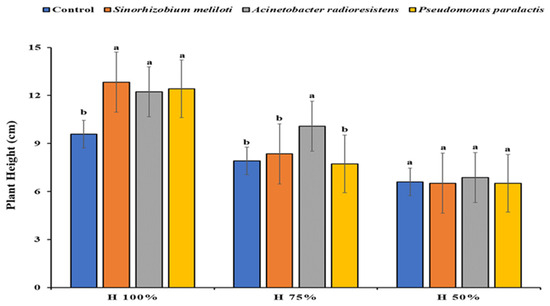
Figure 2.
Plant growth promoting rhizobacteria (PGPR) and moisture content interaction effect on Cucumis sativus height. Columns with different letters are statistically different (Tukey’s, p < 0.05).
3.2. Root Length
The response to root length in PGPR inoculated plants was significantly different (Figure 3a). Substrate moisture content of H100% showed significant differences in root length, increasing 204% with respect to H50% (Figure 3b). Moreover, the interaction between inoculants and substrate moisture was statistically significant (p < 0.05) S. meliloti increased root length at moisture H100% by 158% with respect to not inoculated plants. The seedlings inoculated with PGPR at moisture H75% were significantly different, favoring root elongation by 134% compared to non-inoculated plants, whereas no statistical differences were observed between inoculants and moisture at 50% (Figure 4).
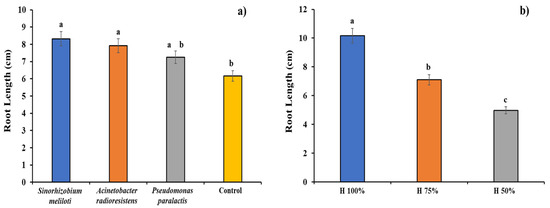
Figure 3.
Plant growth promoting rhizobacteria (PGPR) inoculation (a) and substrate moisture content (b) effect on Cucumis sativus root length. Columns with different letters are statistically different (Tukey’s, p < 0.05).
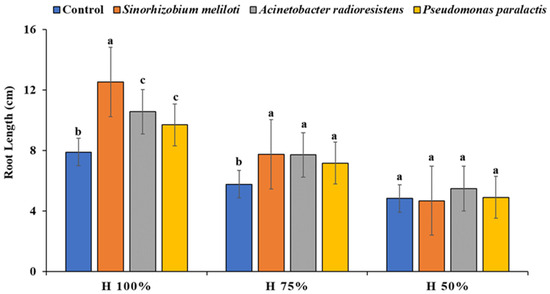
Figure 4.
Plant growth promoting rhizobacteria (PGPR) and substrate moisture content interaction effect on Cucumis sativus root length. Columns with different letters are statistically different (Tukey’s, p < 0.05).
3.3. Fresh Weight
The plants inoculated with PGPR were statistically different with respect to the fresh weight variable, increasing by 134.5% when compared to the control (Figure 5a). Substrate moisture also showed significant differences, the value of this variable increasing by 235% at H100% (Figure 5b). Moreover, the effect of the interactions was not statistically different.
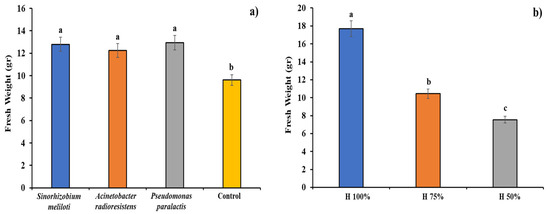
Figure 5.
Plant growth promoting rhizobacteria (PGPR) inoculation (a) and substrate moisture content (b) effect on Cucumis sativus fresh weight. Columns with different letters are statistically different (Tukey’s, p < 0.05).
3.4. Total Phenols
Total phenols production showed significant differences in plants inoculated with PGPR (Figure 6a), increasing content by 117% compared to the control group. Substrate moisture content (Figure 6b) and interactions between PGPR and substrate moisture content did not show statistical differences.
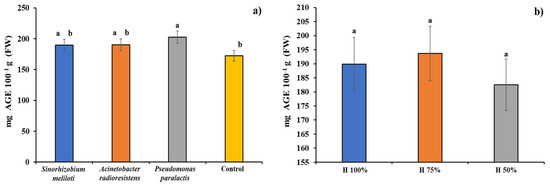
Figure 6.
Plant growth promoting rhizobacteria (PGPR) inoculation (a) and substrate moisture content (b) effect on Cucumis sativus total phenol content. Columns with different letters are statistically different (Tukey’s, p < 0.05).
3.5. Flavonoids
The flavonoids content showed statistically significant differences in PGPR inoculated plants (Figure 7a), increasing by 126% when A. radioresistens was used. Substrate moisture content was statistically different (Figure 7b) at 100% since the flavonoids content increased by 114.5%. However, the interaction between inoculants and substrate moisture content was not statistically significant.
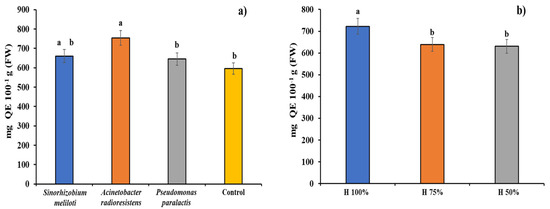
Figure 7.
Plant growth promoting rhizobacteria (PGPR) inoculation (a) and substrate moisture content (b) effect on Cucumis sativus flavonoid content. Columns with different letters are statistically different (Tukey’s, p < 0.05).
3.6. Antioxidant Capacity
The inoculant response with S. meliloti and P. paralactis on C. sativus antioxidant capacity was statistically significant since it increased by 150% compared to non-inoculated plants (Figure 8a). Substrate moisture content at H100 and H75% showed significant differences with respect to substrate moisture content at H50%, and antioxidant capacity increased 116% (Figure 8b). Nevertheless, the analysis of variance did not show significant differences in the interactions of the inoculants used and the substrate moisture contents.
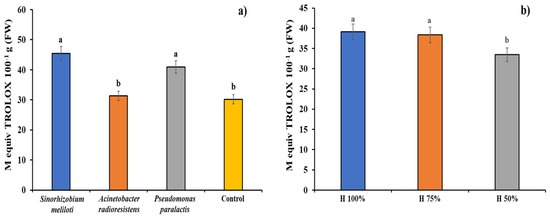
Figure 8.
Plant growth promoting rhizobacteria (PGPR) inoculation (a) and substrate moisture content (b) effect on Cucumis sativus antioxidant capacity. Columns with different letters are statistically different (Tukey’s, p < 0.05).
3.7. Nitrogen Content in Plant
Statistical differences were observed when PGPR were used as inoculants with respect to the control group (Figure 9a), increasing N content in plants by 274%. Substrate moisture content at H100% was also observed to be statistically different, with an increase of nitrogen content in plants of 257% in comparation to moisture content at H50% (Figure 9b). The interaction effect between PGPR used for inoculation and residual moisture showed statistically significant differences (Figure 10). Nitrogen content in plants increased by 194% in residual moisture at H100%; with residual moisture of H75%, N content in seedlings is 337% greater after inoculating cucumber plants; for residual moisture at H50%, PGPR increased N content in plants by 523%.
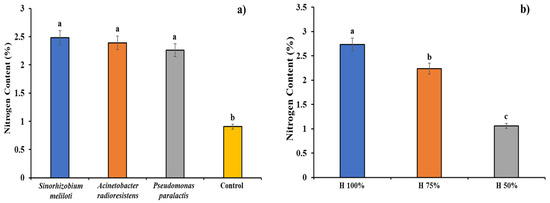
Figure 9.
Plant growth promoting rhizobacteria inoculation (a) and substrate moisture content (b) effect on Cucumis sativus nitrogen (N) content. Columns with different letters are statistically different (Tukey’s p < 0.05).
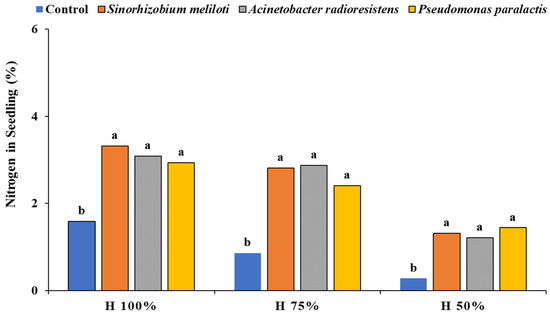
Figure 10.
Plant growth promoting rhizobacteria interaction and substrate moisture content effect on Cucumis sativus nitrogen content. Columns with different letters are statistically different (Tukey’s, p < 0.05).
3.8. Phosphorus (P)
In the case of P, the plants inoculated with A. radioresistens treatment were statistically different (Figure 11a), increasing in content by 124% with respect to the control. Likewise, moisture content at H100% increased P content by 135%. The presence of this element with respect to the plants subjected to H50% moisture showed statistically significant differences (Figure 11b). However, the analysis of variance did not show significant differences in PGPR interaction and substrate moisture content.
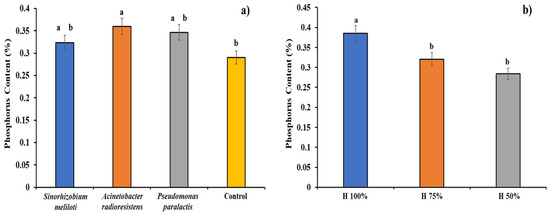
Figure 11.
Plant growth promoting rhizobacteria (a) and substrate moisture content (b) on Cucumis sativus phosphorus content. Columns with different letters are statistically different (Tukey’s, p < 0.05).
4. Discussion
The results obtained in PGPR inoculated plants increased significantly compared to the control group with respect to plant height. As observed, low moisture limited plant growth; interaction between PGPR and substrate moisture content favored plant growth; by reducing hydric stress, A. radioresistens was the inoculant that improved substrate moisture response at 75%. Using PGPR as inoculant increased root length when compared with plants without microorganisms; substrate moisture content also favored radicle growth. As observed, S. meliloti significantly improves root elongation under the substrate moisture conditions assessed. This may reflect the significant increase in the results obtained from plant biomass expressed in fresh weight, since, by inoculating the plants with PGPR, a greater weight was obtained compared to the control. Finally, moisture influenced the fresh weight significantly increasing the biomass. Substrate moisture influenced fresh weight, increasing biomass significantly. Research on PGPR has focused on their importance in promoting plant growth, nutrient management, and phytopathogen control. However, as demonstrated, they may also improve the response to environmental conditions to reduce the effects of different types of hydric stress, temperature, salinity, and alkalinity, among other factors. This adaptation capacity may be more efficient if the strains are isolated from extreme environments [30]. Moreover, the genera Bacillus, Enterobacter, Pseudomonas, and Ochrobactrum have improved the morphological root response in crops, such as wheat, oat, chickpea, and lettuce, among others. Within the responses, main and secondary root elongation can be observed in addition to improving the response under the lack of substrate moisture conditions and increment of secondary roots [31]. The modification of adventitious roots may be caused by indol-3-acetic acid (IAA) production caused by PGPR inoculation, since IAA stimulates cell division and with it root formation, including in unfavorable circumstances [32,33].
Root elongation increased N and P assimilation in plants with PGPR; as reported, S. meliloti has the capacity of fixing nitrogen [34] and A. radioresistens and P. paralactis may produce ammonia [35]. According to the results obtained, a greater N content in plants may be explained in plants inoculated with PGPR compared to the control group since N content may affect apoplastic and symplastic ammonia transport in radicle and tissues, such as adventitious roots and endodermic and cortical roots [36]. Additionally, observations [37] have reported that the lack of moisture affects ammonia transport; thus, the results obtained on N assimilation with respect to moisture may be lower. Likewise, the symbiotic effect of PGPR inoculation in relation to greater amounts of humidity benefits N assimilation in seedlings.
With respect to P content in plants, A. radioresistens was the inoculant that favored a greater absorption of this nutrient when compared to the control group. In the same manner, a greater P assimilation was recorded when substrate moisture was reduced. However, the effect between the inoculants and substrate moisture content was not significant. PGPR and substrate and plant interactions allowed increased obtaining nutrients, as P improves plant metabolic capacity, which allows a greater adaptability when facing abiotic stress [30]. Other mechanisms of PGPR refer to ammonia production and phosphate solubilization, which both play an important role in photosynthesis, metabolic processes, and plant development [38]. Ammonia can be the result of amide hydrolysis activity supplied in plant nutrition schema, while the plant phosphate needs may be supplied by solubilizing the fertilization source used and deposited in the rhizosphere [35].
In the case of phytochemical compound content, total phenols, flavonoids, and antioxidant capacity increased significantly when plants were inoculated with PGPR over the control. On the other hand, moisture showed statistical differences only in flavonoid content and antioxidant capacity. Furthermore, the interaction effect was not significant in any of the phytochemical compounds. Research on stress effect due to drought shows that the presence of reactive oxygen species (ROS), such as superoxide, hydrogen peroxide, and hydroxyl free radicals, including free oxygen, react with proteins, lipids, and DNA, altering the normal functioning of the cells. In this sense, chloroplasts, mitochondria, and peroxisomal signal are the first front of cellular defense against oxidation. In studies on non-enzymatic antioxidants, results have evidenced the increase in total phenol, flavonoid, and antioxidant capacity as defense mechanisms when facing stress by drought, mainly by reducing hydrogen peroxide [6].
5. Conclusions
The application of PGPR as inoculants improves the response in the production of cucumber plants in situations of low substrate moisture. S. meliloti and A. radioresistens showed a positive effect on the growth of cucumber plants. The assimilation of nitrogen and phosphorus by plants was improved by inoculating them with PGPR, and oxidative stress was reduced by increasing phytochemical compounds. It is considered necessary to carry out other types of evaluations of S. meliloti, A. radioresistens, and P. paralactis to establish them as a sustainable alternative for agricultural production.
Author Contributions
Conceptualization, P.P.-R. and G.Z.-S.; methodology, G.Z.-S.; validation, P.P.-R., L.G.H.-M. and M.F.-H.; formal analysis, M.F.-H. and L.L.-C.; investigation, M.F.-H.; resources, J.S.-M.; data curation, L.G.H.-M.; writing—original draft preparation, G.Z.-S.; writing—review and editing, P.P.-R. and L.G.H.-M.; visualization, J.S.-M. and L.L.-C.; supervision, C.S.-M. and L.L.-C.; project administration, C.S.-M.; funding acquisition, G.Z.-S. All authors have read and agreed to the published version of the manuscript.
Funding
This research was funded by Universidad Autónoma Agraria Antonio Narro, Tecnológico Nacional de México and Consejo Nacional de Humanidades, Ciencia y Tecnología, grant number 381114256090022813 and the APC was funded by Universidad Autónoma Agraria Antonio Narro.
Institutional Review Board Statement
Not applicable.
Informed Consent Statement
Not applicable.
Data Availability Statement
The datasets used and analyzed during this study are available from the corresponding authors upon reasonable request.
Acknowledgments
Universidad Autónoma Agraria Antonio Narro, Unidad Laguna (UAAAN UL), Consejo Nacional de Humanidades, Ciencia y Tecnología (CONAHCyT), Instituto Tecnológico de Torreón (ITT), and technical support of Q. I. Juan Carlos Mejía Cruz (member of Laboratorio de Agroecología) of the Universidad Autónoma Agraria Antonio Narro; D. Fischer for translation and edition.
Conflicts of Interest
The authors declare no conflicts of interest.
References
- Rai, A.; Chugh, V.; Pandey, S. Cucumber (Cucumis sativus L.): Genetic Improvement for Nutraceutical Traits. In Compendium of Crop Genome Designing for Nutraceuticals; Springer Nature: Singapore, 2023; pp. 1527–1544. [Google Scholar] [CrossRef]
- Aderinola, T.A.; Abaire, K.E. Quality acceptability, nutritional composition and antioxidant properties of carrot-cucumber juice. Beverages 2019, 5, 15. [Google Scholar] [CrossRef]
- Ji, F.; Wei, S.; Liu, N.; Xu, L.; Yang, P. Growth of cucumber seedlings in different varieties as affected by light environment. Int. J. Agric. Biol. Eng. 2020, 13, 73–78. [Google Scholar] [CrossRef]
- Roy, S.; Kapoor, R.; Mathur, P. Revisiting Changes in Growth, Physiology and Stress Responses of Plants under the Effect of Enhanced CO2 and Temperature. Plant Cell Physiol. 2024, 65, 4–19. [Google Scholar] [CrossRef]
- Considine, M.J.; Foyer, C.H. Oxygen and reactive oxygen species-dependent regulation of plant growth and development. Plant Physiol. 2021, 186, 79–92. [Google Scholar] [CrossRef] [PubMed]
- Suman, S.; Bagal, D.; Jain, D.; Singh, R.; Singh, I.K.; Singh, A. Biotic stresses on plants: Reactive oxygen species generation and antioxidant mechanism. In Frontiers in Plant-Soil Interaction; Academic Press: Cambridge, MA, USA, 2021; pp. 381–411. [Google Scholar] [CrossRef]
- Qi, J.; Song, C.P.; Wang, B.; Zhou, J.; Kangasjärvi, J.; Zhu, J.K.; Gong, Z. Reactive oxygen species signaling and stomatal movement in plant responses to drought stress and pathogen attack. J. Integr. Plant Biol. 2018, 60, 805–826. [Google Scholar] [CrossRef] [PubMed]
- Kour, D.; Yadav, A.N. Bacterial Mitigation of Drought Stress in Plants: Current Perspectives and Future Challenges. Curr. Microbiol. 2022, 79, 248. [Google Scholar] [CrossRef] [PubMed]
- Yunusov, S.; Bolikulov, F.; Makhmanazarov, Z.; Yakhshiboev, D. Effect of growth regulators on cucumber seed fertility. E3S Web Conf. 2023, 421, 02013. [Google Scholar] [CrossRef]
- Gowtham, H.G.; Singh, S.B.; Shilpa, N.; Aiyaz, M.; Nataraj, K.; Udayashankar, A.C.; Amruthesh, K.N.; Murali, M.; Poczai, P.; Gafur, A.; et al. Insight into recent progress and perspectives in improvement of antioxidant machinery upon PGPR augmentation in plants under drought stress: A review. Antioxidants 2022, 11, 1763. [Google Scholar] [CrossRef]
- García-López, J.V.; Redondo-Gómez, S.; Flores-Duarte, N.J.; Zunzunegui, M.; Rodríguez-Llorente, I.D.; Pajuelo, E.; Mateos-Naranjo, E. Exploring through the use of physiological and isotopic techniques the potential of a PGPR-based biofertilizer to improve nitrogen fertilization practices efficiency in strawberry cultivation. Front. Plant Sci. 2023, 14, 1243509. [Google Scholar] [CrossRef]
- Pranaw, K.; Kumawat, K.C.; Meena, V.S. Plant growth-promoting rhizobacteria (PGPR) and plant hormones: An approach for plant abiotic stress management and sustainable agriculture. Front. Microbiol. 2023, 14, 1285756. [Google Scholar] [CrossRef]
- Gul, A.; Nawaz, S. Role of phytohormones in biotic vs abiotic stresses with respect to PGPR and autophagy. In Phytohormones and Stress Responsive Secondary Metabolites; Academic Press: Cambridge, MA, USA, 2023; pp. 41–62. [Google Scholar]
- Basu, A.; Prasad, P.; Das, S.N.; Kalam, S.; Sayyed, R.Z.; Reddy, M.S.; El Enshasy, H. Plant growth promoting rhizobacteria (PGPR) as green bioinoculants: Recent developments, constraints, and prospects. Sustainability 2021, 13, 1140. [Google Scholar] [CrossRef]
- Joshi, S.; Jaggi, V.; Tiwari, S.; Sah, V.K.; Sahgal, M. Multitrate phosphate solubilizing bacteria from Dalbergia sissoo Roxb. Rhizosphere in natural forests of Indian Central Himalayas. Environ. Ecol. 2019, 3, 894–908. [Google Scholar]
- Sharghi, A.; Badi, H.N.; Bolandnazar, S.; Mehrafarin, A.; Sarikhani, M.R. Morphophysiological and phytochemical responses of fenugreek to plant growth promoting rhizobacteria (PGPR) under different soil water levels. Folia Hortic. 2018, 30, 215–228. [Google Scholar] [CrossRef]
- Rosier, A.; Beauregard, P.B.; Bais, H.P. Quorum quenching activity of the PGPR Bacillus subtilis UD1022 alters nodulation efficiency of Sinorhizobium meliloti on Medicago truncatula. Front. Microbiol. 2021, 11, 596299. [Google Scholar] [CrossRef] [PubMed]
- Ibrahim, G.A. The role of salt-tolerant plant growth promoting bacteria in increasing the resistance of canola to salt-stress. J. Soil Sci. Agric. Eng. 2022, 13, 147–156. [Google Scholar] [CrossRef]
- Salazar-Ramírez, M.T.; Gallegos-López, D.A.; Hernández-Ordaz, G.; Preciado-Rangel, P.; Vidal, J.A.O. Inoculated growth promoting rhizobacteria in Serrano chili pepper (Capsicum annuum L.) seedlings under abiotic stress conditions. Agrociencia 2023, 57, 1–12. [Google Scholar]
- Akköprü, A.; Özaktan, H. Identification of rhizobacteria that increase yield and plant tolerance to angular leaf spot disease in cucumber. Plant Prot. Sci. 2018, 54, 67–73. [Google Scholar] [CrossRef]
- Carrillo, A.; Puente, M.; Castellanos, T.; Bashan, Y. Aplicaciones Biotecnológicas de Ecología Microbiana, Manual de Laboratorio. [Biotechnological Applications of Microbial Ecology. Laboratory Manual]; Pontificia Universidad Javeriana: Santa Fe de Bogotá, Colombia; Centro de Investigaciones Biológicas de Noroeste SC: La Paz, Mexico, 1998. [Google Scholar]
- Steiner, A.A. A universal method for preparing nutrient solutions of a certain desired composition. Plant Soil 1961, 15, 134–154. [Google Scholar] [CrossRef]
- Villanueva, D.M.L. Eficacia de biofungicidas frente a la caída de plántula de pepino, inducida por Pythium aphanidermatum. Rev. Investig. Agroproducción Sustentable 2018, 2, 72–78. [Google Scholar] [CrossRef]
- Borges-Gómez, L.; Cervantes-Cárdenas, L.; Ruiz-Novelo, J.; Soria-Fregoso, M.; Reyes-Oregel, V.; Villanueva-Couoh, E. Capsaicinoides en chile habanero (Capsicum chinense Jacq.) bajo diferentes condiciones de humedad y nutrición. Terra Latinoam. 2010, 28, 35–41. [Google Scholar]
- Singleton, V.L.; Orthofer, R.; Lamuela-Raventós, R.M. Analysis of total phenols and other oxidation substrates and antioxidants using a folic-ciocalteu reagent. Methods Enzym. 1999, 299, 152–178. [Google Scholar]
- Lamaison, J.L.C.; Carnet, A. Contents in main flavonoid compounds of Crataegus Monogyna Jacq. and Crataegus laevigata (Poiret) D. C. flowers at different development stages. Pharm. Acta Helv. 1990, 65, 315–320. [Google Scholar]
- Brand-Williams, W.; Cuvelier, M.E.; Berset, C.L.W.T. Use of a free radical method to evaluate antioxidant activity. LWT-Food Sci. Technol. 1995, 28, 25–30. [Google Scholar] [CrossRef]
- Bremmer, J.M.; Keeney, D.R. Steam distillation methods for determination of ammonium, nitrate and nitrite. Anal. Chim. Acta 1965, 32, 485–495. [Google Scholar] [CrossRef]
- Olsen, S.R.; Sommers, L.E. Phosphorus Soluble in Sodium Bicarbonate. In Methods of Soils Analysis. Part 2, Chemical and Microbiological Properties; Page, A.L., Miller, R.H., Keeney, D.R., Eds.; American Society of Agronomy: Madison, WI, USA; Soil Science Society of America: Madison, WI, USA, 1982; pp. 404–430. [Google Scholar]
- Kour, D.; Rana, K.L.; Sheikh, I.; Kumar, V.; Yadav, A.N.; Dhaliwal, H.S.; Saxena, A.K. Alleviation of drought stress and plant growth promotion by Pseudomonas libanensis EU-LWNA-33, a drought-adaptive phosphorus-solubilizing bacterium. Proc. Natl. Acad. Sci. India Sect. B Biol. Sci. 2020, 90, 785–795. [Google Scholar] [CrossRef]
- Bouremani, N.; Cherif-Silini, H.; Silini, A.; Bouket, A.C.; Luptakova, L.; Alenezi, F.N.; Baranov, O.; Belbahri, L. Plant growth-promoting rhizobacteria (PGPR): A rampart against the adverse effects of drought stress. Water 2023, 15, 418. [Google Scholar] [CrossRef]
- Ambreetha, S.; Chinnadurai, C.; Marimuthu, P.; Balachandar, D. Plant-associated Bacillus modulates the expression of auxin-responsive genes of rice and modifies the root architecture. Rhizosphere 2018, 5, 57–66. [Google Scholar] [CrossRef]
- Khan, A.L.; Waqas, M.; Kang, S.M.; Al-Harrasi, A.; Hussain, J.; Al-Rawahi, A.; Al-Khiziri, S.; Ullah, I.; Ali, L.; Jung, H.-Y.; et al. Bacterial endophyte Sphingomonas sp. LK11 produces gibberellins and IAA and promotes tomato plant growth. J. Microbiol. 2014, 52, 689–695. [Google Scholar] [CrossRef] [PubMed]
- Ruiz, B.; Le Scornet, A.; Sauviac, L.; Rémy, A.; Bruand, C.; Meilhoc, E. The nitrate assimilatory pathway in Sinorhizobium meliloti: Contribution to NO production. Front. Microbiol. 2019, 10, 1526. [Google Scholar] [CrossRef]
- Fouda, A.; Eid, A.M.; Elsaied, A.; El-Belely, E.F.; Barghoth, M.G.; Azab, E.; Gobouri, A.; Hassan, S.E.D. Plant growth-promoting endophytic bacterial community inhabiting the leaves of Pulicaria incisa (Lam.) DC inherent to arid regions. Plants 2021, 10, 76. [Google Scholar] [CrossRef]
- Calvo, P.; Zebelo, S.; McNear, D.; Kloepper, J.; Fadamiro, H. Plant growth-promoting rhizobacteria induce changes in Arabidopsis thaliana gene expression of nitrate and ammonium uptake genes. J. Plant Interact. 2019, 14, 224–231. [Google Scholar] [CrossRef]
- Ding, L.; Lu, Z.; Gao, L.; Guo, S.; Shen, Q. Is nitrogen a key determinant of water transport and photosynthesis in higher plants upon drought stress? Front. Plant Sci. 2018, 9, 1143. [Google Scholar] [CrossRef] [PubMed]
- Afzal, I.; Iqrar, I.; Shinwari, Z.K.; Yasmin, A. Plant growth-promoting potential of endophytic bacteria isolated from roots of wild Dodonaea viscosa L. Plant Growth Regul. 2017, 81, 399–408. [Google Scholar] [CrossRef]
Disclaimer/Publisher’s Note: The statements, opinions and data contained in all publications are solely those of the individual author(s) and contributor(s) and not of MDPI and/or the editor(s). MDPI and/or the editor(s) disclaim responsibility for any injury to people or property resulting from any ideas, methods, instructions or products referred to in the content. |
© 2024 by the authors. Licensee MDPI, Basel, Switzerland. This article is an open access article distributed under the terms and conditions of the Creative Commons Attribution (CC BY) license (https://creativecommons.org/licenses/by/4.0/).